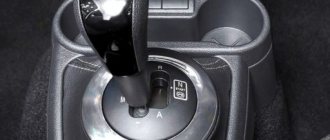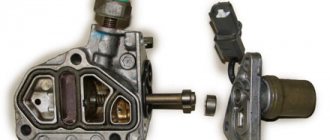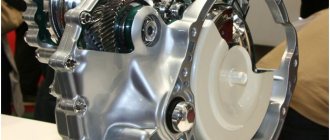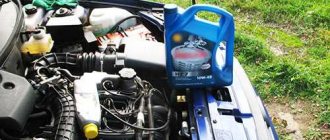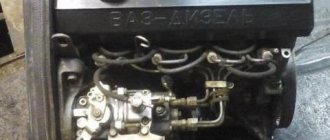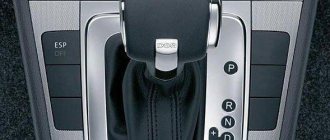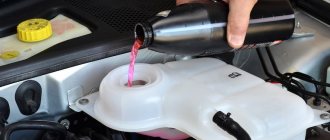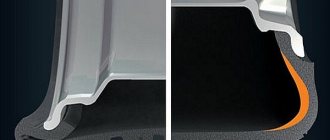Any car requires an engine oil change after a certain mileage interval; as a rule, technical documentation requires an interservice change at least once a year or 15,000 km. mileage, depending on what comes first, experts recommend cutting this figure in half.
There are two replacement methods: classic (oil is removed from the engine through the drain plug) and express replacement, also known as vacuum (oil is removed through the dipstick hole).
In the case of a classic replacement, everything is extremely clear and described many times; let’s look at the replacement through a probe in more detail.
The first thing to note is the fact that an express oil change cannot be carried out without special equipment. Therefore, for vacuum replacement you need:
- Container for collecting waste liquid;
- Manual or automatic installation for pumping out oil;
- A set of special probes for extracting technical fluids.
Pros and cons of changing oil through the dipstick
The advantages of this method are obvious to everyone:
- It's easy to do. There is no need to unscrew the engine protection, remove the drain bolts and first drive the car into the pit. Of course, this does not apply to those cars where you have to crawl under the car to change the oil filter.
- It's free. Once you have purchased such a device, you can use it for a very long time. In this case, you do not need to spend 250-300 rubles for a replacement.
As for the disadvantages:
- There is a possibility that combustion products of additives and oil remain at the bottom. This is not certain, so it cannot be confirmed. The opinions of experts on this matter are contradictory.
- Sometimes it is not possible to pump out all the oil. This is possible if it is very viscous (dense) or the car is on a slope.
- No benefit for cars where the filter is replaced in a pit.
Advantages
The advantage of this method is that you do not need to unscrew the lower protection and bolts and drive the car into the pit. At a minimum, this will save money and time, because you won’t have to take the car to a service station to replace fuel and lubricants. All this will take about 5-10 minutes, no more. If you wish, you can even use an automatic pump (not a manual one), which drivers almost always have in case of tire inflation. With it, the oil is pumped out much faster. Actually, these are all the advantages of this method.
Device for changing oil through dipstick
This device is quite simple, and its operating principle is based on creating a pressure difference inside and outside the container. It consists of:
- Main tank.
- A pump for pumping air out of the tank and creating a pressure difference.
- A hose through which oil will flow from the oil pan.
The process looks like this:
- Combine all these elements. That is, connect the hose to the tank, insert the pump into it from above.
- Insert the hose into the hole for the oil dipstick until it stops. That is, until the tip of the hose rests on the bottom of the pan. The hose itself is quite thin, so it easily penetrates the hole.
- You pump out the air and create a pressure difference. You need to pump until it becomes hard.
- Afterwards the pump can be removed. Due to the presence of a check valve in the main tank, the pressure inside will not go anywhere. Engine oil will begin to slowly flow into the main tank.
Depending on what viscosity of oil is used and what condition it is in, the process of changing the oil through the dipstick will last about 10-15 minutes. It rarely lasts 20 minutes if the replacement is carried out on a car with a large engine.
The effectiveness of this method
Many owners doubt the effectiveness of changing oil using this method. This is fair, because there is a possibility that not all the oil will be pumped out through the dipstick hole. However, many people carried out a test and first pumped out the oil using a pump through the dipstick, and only then unscrewed the plug at the bottom. It was impossible to collect a single drop of oil from the bottom, so we can confidently confirm the effectiveness of using such installations. Every last drop of oil is pumped out, but sediment may remain at the bottom.
Draining oil with washer pump
This is the same budgetary, but labor-intensive and “dangerous” path. There are a lot of washer pumps - you want them from VAZ, you want them from GAZ, you want them from VAG. But remember - they are not designed for pumping oil, even when heated, which means they can fail at any time.
For example, let’s take the KALUGA ENTS2512 washer pump, which produces a power of 1.1 atmospheres and is powered by 12 Volts. Perfectly suits our conditions. You still need to buy tubes for it - you can take any, but it is better to choose oil- and gasoline-resistant ones, for obvious reasons. Another important parameter will be the internal diameter of the tube - it is 5 millimeters. In order not to deceive yourself, we take 4 meters of such a hose and cut it in half.
Then we need to somehow power this pump. On its body there are 2 male connectors - positive and negative. We buy (or get it by any other possible means) 2 female connectors, 2 wires and crocodiles. We also make sure to buy a syringe - any one, the main thing is that its nozzle fits the cross-section of the tube, it will be useful to us later. We put it all together and get a pump that can be powered from the battery. The main thing is not to confuse the polarity.
After you have decided through which fitting the pump draws liquid, connect the hoses, insert one into the dipstick body, and the other into a container for testing.
We turn it on and... nothing happens. Why? Because these pumps are unable to pick up oil and they need to be helped to take their first steps. This is where the syringe we bought earlier comes into play. When the pump is turned on, through the outlet tube (which goes into the drainage container), you need to pump out a little air from the pumping line - this way the pump will take the liquid and be able to work.
In addition to the materials required above, you should be patient - with this pump you will be pumping out oil for quite a long time, its performance is low. Well, of course, as we have already warned you, it can fail at any moment.
Oh yes, these VAZ crafts also love to leak, so don’t be surprised if something happens.
Pure experiment
Insert the tube into the hole for the dipstick and connect it to the pump. On the other side we fix the second tube - to drain the oil. We lower its second end into a 5-liter plastic drinking water bottle (a transparent container allows you to control the volume of drained working fluid). We make sure that the pump is turned off, then connect the terminals of the device to the car battery, observing the polarity.
We place the pump in the engine compartment so that it does not fall during operation. It can be noted that the device operates quite quietly.
We place the pump in the engine compartment so that it does not fall during operation. It can be noted that the device operates quite quietly.
Turn on the pump and start pumping. The oil rises through a tube inserted into the dipstick hole, passes through the device and flows out of the second tube into a plastic container.
After a few minutes, the sound made by the oil pump motor changed as the engine became easier to operate. This means the oil has run out. Let's verify this by moving the tube inserted into the probe hole. If the sound of the pump does not change, turn off the device.
Oil change devices
There are many devices on the market that allow you to change the oil yourself. Moreover, there are mechanical models in which negative pressure must be created using a hand pump, but there are also electric ones. The first ones are cheap, and their price varies from one thousand to two thousand rubles. More expensive electric models are sold in a very wide price range: from 4 to 15 thousand rubles.
The most popular is the HC 2081 installation with a tank capacity of 80 liters. Of course, it is not intended for one-time use. Such models can be installed at various service stations, where drivers come every day to drain/refuel fuels and lubricants.
As for the usual mechanical device, you can generally make it yourself. You only need a long hose that would fit through the hole for the dipstick with a hard, unbendable tip, a pump to pump out air, and a container where all the oil will flow. The main difficulty here is to create a sealed space inside this container. Otherwise, it will not be possible to create a pressure difference, and the oil will remain in the engine.
Experts' opinion
It is fair to note that some experts do not agree with the opinion that combustion products may precipitate. If you use good oil and change it at least every 10 thousand kilometers, then there can be no sediment. This completely negates the disadvantages of this method. Indirect confirmation of this is the fact that many car service stations have such devices for pumping out oil without the need to remove protection and drain bolts. And since masters resort to this method, this indicates its harmlessness. Also, in some engine models (for example, in boat engines), the oil can only be changed in this way. Structurally, boat engines are not much different from car engines, because they “eat” the same gasoline and use the same oil for lubrication. And since the manufacturer himself provides for changing the oil by pumping it out using a pump, then this can also be done in a car.
Pumping oil through the dipstick - basic methods
There are two main methods for pumping oil out of the engine through the dipstick - using a pump, using a syringe. There is also vacuum pumping, but this method is more complicated than the first two and is generally applicable in service conditions. We invite you to familiarize yourself with the methods that you can apply even in the parking lot in front of your house.
We warn you: these methods of draining engine oil do not have the same effect as draining oil through a plug. The plug is located at the lowest point of the crankcase, so the maximum amount of old oil is removed through it. The methods described in the article cope with this to a maximum of 95-98%. But this is not scary, because with every oil change, the oil filter is also changed, which will easily absorb all the crap that remains in the oil pan.
Also, before this method of changing the oil, the engine needs to be thoroughly warmed up - this way the oil will get maximum fluidity, which means it will drain through the dipstick as efficiently as possible.
Flaws
It is worth noting that changing oil through a dipstick is not perceived in the best way on various forums. Many car owners insist that this cannot be done, although in many service stations technicians resort to this method.
The most basic argument against changing engine oil through a dipstick is that when the engine is running, the oil wears out, and many of its additives, which are necessarily included in the composition, precipitate. All this sediment, including dirt and combustion products of additives, remains at the bottom. When changing the oil through the dipstick with your own hands, it is impossible to get all this sediment from the bottom, and even after the change it will lie there. By pouring in new oil, the old sediment will mix with the new one, and this will lead to the fact that the efficiency of the new oil will be reduced. It is quite logical that with each new pumping through the dipstick, the sediment will remain large, and ultimately this will seriously reduce the service life of the motor. Therefore, the conclusion is this: you can change the oil through the dipstick yourself, but you shouldn’t get carried away with it. At a minimum, it is necessary to make a replacement in the usual way (draining oil from the bottom through the drain bolts) after each fuel and lubricants change through the dipstick, but for what?
How to pump oil out of the engine if draining is impossible?
The only possible way is a vacuum pump. But these are only available at service stations; to use them in the garage, you will have to shell out a tidy sum. You will have to pump it out through the dipstick; the oil filler neck is not suitable for this.
You can make something like a vacuum pump yourself:
- From a pastry syringe. The pressure is low, but the volume is good. You can pump out 200-300 ml in one go.
- From a medical syringe. The situation is the opposite: excellent pressure, but small volume.
- From a rubber syringe or PET bottle with thick walls. If the container is compressed, back pressure is created when the shape is restored.
Examination
To understand how effectively the electric pump coped with its task, lift the car on a lift and unscrew the drain plug in the pan. The oil flows out quite intensively. During our last experiment, when we used a vacuum installation for similar work, this did not happen.
We waited until the remaining oil in the system drained completely to assess its volume. Almost 200 ml has been collected!
We waited until the remaining oil in the system drained completely to assess its volume. Almost 200 ml has been collected!
The conclusion is obvious: you should not change the engine oil yourself using an electric pump. And although the device is interesting, it clearly needs improvement.
